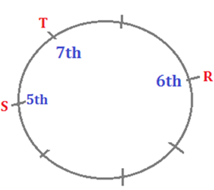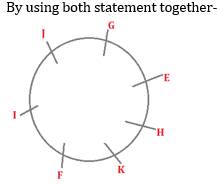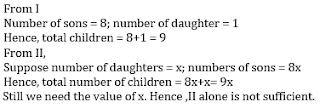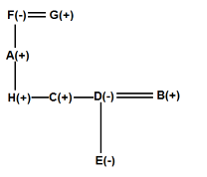Reasoning Questions for SBI CLERK MAINS 2019
Directions (1-5): निम्नलिखित जानकारी का ध्यानपूर्वक अध्यन कीजिये और दिए गए प्रश्नों के उत्तर दीजिये:
P, Q, R, S, T, U और V सात खिलाड़ी हैं जो एक ही टीम के लिए खेलते हैं. एक मैच की बैठक में, वे सभी एक वृताकार मेज के चारो ओर केंद्र की ओर उन्मुख होकर बैठे हैं. साथ ही प्रत्येक खिलाड़ी को अपना प्रशिक्षण पूरा करना है, जो उन्हें सौंपा गया है. कोई भी दो खिलाड़ी साथ में प्रशिक्षण पूरा नहीं कर सकते और कोई भी दो आसान्न खिलाड़ी एकदूसरे के ठीक बाद अपना प्रशिक्षण पूरा नहीं करते हैं.
P, Q से ठीक पहले अपना प्रशिक्षण पूरा करता है. R, S के बाएं से तीसरे स्थान पर बैठा है लेकिन वह अपना प्रशिक्षण S के बाद पूरा करता है. Q, V के ठीक बाएं बैठा है. T उस खिलाड़ी के ठीक बाएं बैठा है, जो दो खिलाड़ियों के पहले अपना प्रशिक्षण पूरा करता है. U, Q के ठीक बाद अपना प्रशिक्षण पूरा करता है लेकिन R के बाद नहीं. V के पहले अपना प्रशिक्षण पूरा करने वाली खिलाड़ियों की संख्या V के बाद अपना प्रशिक्षण पूरा करने वाली खिलाड़ियों के समान है. U उस व्यक्ति के दायें से दूसरे स्थान पर बैठा है जो सबसे पहले अपना प्रशिक्षण पूरा करता है.
Q1. Q के दायें से चौथे स्थान पर कौन बैठा है?
The number of players who complete their training before V is same as the numbers of players, who complete their training after V. Hence V completes his training in 4th position. P completes his training immediately before Q. U completes his training immediately after Q but not after R. Hence P, Q, U completes his training in either 1st, 2nd, 3rd position respectively or in 5th, 6th, 7th position respectively. If U completes his training in 7th position, then R must be complete his training before U, which cannot be possible. So P, Q, U completes his training in 1st, 2nd, 3rd position respectively.
Also we try to complete circular arrangement from the given conditions; R sits third to the left of S but completes his training after S. Hence S completes his training before R. T sits to the immediate left of the player, who completes his training before two players (means 5th position player). No two adjacent player finish their training immediately one after the other. Hence S completes his training in 5th position. And T completes his training in 7th position and R completes his training in 6th position.

Q sits to the immediate left of V. Hence V sits either immediate left of R or second left of R. If V sits immediate left of R, then Either U or P sits immediate right of S, which is not possible. So V sits second to the left of R. And U sits immediate right of R. U sits 2nd to the right of person who completes his training 1st.
The final arrangement are-

Q2. P के पहले कितने खिलाड़ी अपना प्रशिक्षण पूरा करते हैं?
The number of players who complete their training before V is same as the numbers of players, who complete their training after V. Hence V completes his training in 4th position. P completes his training immediately before Q. U completes his training immediately after Q but not after R. Hence P, Q, U completes his training in either 1st, 2nd, 3rd position respectively or in 5th, 6th, 7th position respectively. If U completes his training in 7th position, then R must be complete his training before U, which cannot be possible. So P, Q, U completes his training in 1st, 2nd, 3rd position respectively.
Also we try to complete circular arrangement from the given conditions; R sits third to the left of S but completes his training after S. Hence S completes his training before R. T sits to the immediate left of the player, who completes his training before two players (means 5th position player). No two adjacent player finish their training immediately one after the other. Hence S completes his training in 5th position. And T completes his training in 7th position and R completes his training in 6th position.

Q sits to the immediate left of V. Hence V sits either immediate left of R or second left of R. If V sits immediate left of R, then Either U or P sits immediate right of S, which is not possible. So V sits second to the left of R. And U sits immediate right of R. U sits 2nd to the right of person who completes his training 1st.
The final arrangement are-

Q3. बिंदु S से निम्नलिखित में से कौन सा घडी की सुई कि दिशा के विपरीत बैठने का क्रम है(S शामिल करते हुए)?
The number of players who complete their training before V is same as the numbers of players, who complete their training after V. Hence V completes his training in 4th position. P completes his training immediately before Q. U completes his training immediately after Q but not after R. Hence P, Q, U completes his training in either 1st, 2nd, 3rd position respectively or in 5th, 6th, 7th position respectively. If U completes his training in 7th position, then R must be complete his training before U, which cannot be possible. So P, Q, U completes his training in 1st, 2nd, 3rd position respectively.
Also we try to complete circular arrangement from the given conditions; R sits third to the left of S but completes his training after S. Hence S completes his training before R. T sits to the immediate left of the player, who completes his training before two players (means 5th position player). No two adjacent player finish their training immediately one after the other. Hence S completes his training in 5th position. And T completes his training in 7th position and R completes his training in 6th position.

Q sits to the immediate left of V. Hence V sits either immediate left of R or second left of R. If V sits immediate left of R, then Either U or P sits immediate right of S, which is not possible. So V sits second to the left of R. And U sits immediate right of R. U sits 2nd to the right of person who completes his training 1st.
The final arrangement are-

Q4. निम्नलिखित में से कौन R के ठीक बाद अपना प्रशिक्षण पूरा करता है?
The number of players who complete their training before V is same as the numbers of players, who complete their training after V. Hence V completes his training in 4th position. P completes his training immediately before Q. U completes his training immediately after Q but not after R. Hence P, Q, U completes his training in either 1st, 2nd, 3rd position respectively or in 5th, 6th, 7th position respectively. If U completes his training in 7th position, then R must be complete his training before U, which cannot be possible. So P, Q, U completes his training in 1st, 2nd, 3rd position respectively.
Also we try to complete circular arrangement from the given conditions; R sits third to the left of S but completes his training after S. Hence S completes his training before R. T sits to the immediate left of the player, who completes his training before two players (means 5th position player). No two adjacent player finish their training immediately one after the other. Hence S completes his training in 5th position. And T completes his training in 7th position and R completes his training in 6th position.

Q sits to the immediate left of V. Hence V sits either immediate left of R or second left of R. If V sits immediate left of R, then Either U or P sits immediate right of S, which is not possible. So V sits second to the left of R. And U sits immediate right of R. U sits 2nd to the right of person who completes his training 1st.
The final arrangement are-

Q5. निम्नलिखित में से कौन S के ठीक दायें बैठा है?
The number of players who complete their training before V is same as the numbers of players, who complete their training after V. Hence V completes his training in 4th position. P completes his training immediately before Q. U completes his training immediately after Q but not after R. Hence P, Q, U completes his training in either 1st, 2nd, 3rd position respectively or in 5th, 6th, 7th position respectively. If U completes his training in 7th position, then R must be complete his training before U, which cannot be possible. So P, Q, U completes his training in 1st, 2nd, 3rd position respectively.
Also we try to complete circular arrangement from the given conditions; R sits third to the left of S but completes his training after S. Hence S completes his training before R. T sits to the immediate left of the player, who completes his training before two players (means 5th position player). No two adjacent player finish their training immediately one after the other. Hence S completes his training in 5th position. And T completes his training in 7th position and R completes his training in 6th position.

Q sits to the immediate left of V. Hence V sits either immediate left of R or second left of R. If V sits immediate left of R, then Either U or P sits immediate right of S, which is not possible. So V sits second to the left of R. And U sits immediate right of R. U sits 2nd to the right of person who completes his training 1st.
The final arrangement are-

Directions (6-10): नीचे दिए गए प्रत्येक प्रश्न में, एक प्रश्न और उसके बाद दो कथन I और II दिए गए हैं। आपको निर्णय लेना है कि कथन में दिया गया डाटा प्रश्न का उत्तर देने के लिए पर्याप्त है या नहीं.
Q6. केंद्र की ओर उन्मुख सात व्यक्तियों E, F, G, H, I, J और K में से G के ठीक दायें कौन बैठा है?
I. I, H के बाएं से तीसरे स्थान पर और G, H के बाएं से तीसरे स्थान पर और G, I के बाएं से दूसरे स्थान पर बैठा है, जो G के दायें से तीसरे स्थान पर बैठा है और वह E के बाएं से तीसरे स्थान पर है.
II. F उस व्यक्ति के बाएं से चौथे स्थान प् रही जो E के ठीक दायें बैठा है. H, K के ठीक दायें है.
Q7. सात व्यक्तियों के एक परिवार में, K किस प्रकार Z से संबंधित है?
I. X, S का भाई है और Y, S की बहन है, जो परिवार का अविवाहित सदस्य है. Z, Y से विवाहित है.
II. S की माँ R के पति से विवाहित है, जिसका एक पुत्र है और दो पुत्रियाँ हैं. T, K की पत्नी की डॉटर इन लॉ है.
Q8. पांच व्यक्तयों P, Q, R, S और T में से सबसे लंबा कौन है?
I. S, T, P और R से लंबा है लेकिन Q के समान लंबा नहीं है.
II. S, R से लंबा है लेकिन Q के सामान लंबा नहीं, जो T से लंबा है.
Q9. A, B, C, D और E में से सबसे अधिक वेतन किसका है?
I. A और B का संयुक्त वेतन C और D के संयुक्त वेतन से अधिक है लेकिन E का वेतन A और B से अधिक है.
II. A के वेतन और C के वेतन के बीच का अंतर D और B के वेतन के बीच के अंतर से अधिक है जहां A का वेतन और D का वेतन क्रमशः C और B के वेतन से अधिक है.
From II, Salary of (A-C) > Salary of (D-B); Salary of A > Salary of C and D > B
From I and II, we get salary of E > salary of A,B or C. But we still do not know among D and E whose salary is the highest.
Q10. मिस्टर X के कितने बच्चे हैं?
I. मिस्टर X के आठ बेटे हैं और प्रत्येक की एक बहन है.
II. मिस्टर X के बेटों की संख्या उनकी बेटी की संख्या से आठ गुना है.
Q11. कथन: प्रसिद्ध मलयालम लेखक केपी रामानुन्नी ने एक गुमनाम धमकी पत्र के बारे में पुलिस शिकायत दर्ज कराई जिसमें उन्हें चेतावनी दी गई थी कि अगर वह छह महीने के भीतर इस्लाम में परिवर्तित नहीं हुए तो उनका दाहिना हाथ और बायां पैर काट दिया जाएगा.
निम्नलिखित में से कौन सा कथन को निरस्त करता है?
(i) धमकी पत्र छह दिन पहले श्री रामानुन्नी के कोझिकोड निवास पर भेजा गया था.
(ii) लेखक ने कहा कि हालांकि इस बात का कोई संकेत नहीं था कि पत्र के पीछे कौन था.
(iii) श्री रामानुन्नी ने कहा कि हालांकि उन्होंने शुरू में पत्र को नजरअंदाज कर दिया था, अन्य वरिष्ठ लेखकों ने उन्हें पुलिस शिकायत दर्ज करने की सलाह दी.
we have to choose an option which negates the statement.
not negates the statement, it substantiates that a letter was indeed sent to
Mr. Ramanunni.
not negates the statement, it simply gives an additional detail about the
incident.
Option (iii) does not negates the statement, it
substantiates that a letter was indeed sent to Mr. Ramanunni.
Q12. कथन: एक अखबार की रिपोर्ट - "एक निषिद्ध नौकरी वाला मुस्लिम व्यक्ति". मोहम्मद लाहम लेबनान में एक मूर्तिकार है जो पांच साल पहले अपनी पत्नी, दो बच्चों और अपने माता-पिता के साथ सीरिया में युद्ध छोड़कर भाग गया था.
उपरोक्त कथन में से निम्नलिखित में से किसकी परिकल्पना की जा सकती है?
(i) मोहम्मद लाह्मल ईसाई संतों की मूर्तियां बनाते हैं जबकि इस्लामी परंपरा भौतिक रूप में देवताओं के चित्रण को हतोत्साहित करती है.
(ii) मोहम्मद लाहम अमेरिकी उपमहाद्वीप में एक अवैध अप्रवासी है.
(iii) मोहम्मद खतरे से भाग गया और इसलिए उसकी सीरिया में वापसी वर्जित है.
we have to choose an option which can be hypothesized from the facts given in
the statement.
hypothesized from the statement as his religion is clearly mentioned in the
title of the report which means that it might have something to do with
religion.
wrong statement as Lebanon is not a part of American subcontinent.
Option (iii) is not a correct choice as its his
job that is being referred to as forbidden in the statement
Directions (13-15): निम्नलिखित जानकारी का ध्यानपूर्वक अध्यन कीजिये और नीचे दिए गये प्रश्नों के उत्तर दीजिये.
A, B, C, D, E, F, G और H एक परिवार में आठ सदस्य हैं. F, D और E परिवार की महिलायें हैं. D, जो B से विवाहित है वह दूसरा सबसे छोटा सदस्य है. दोनों H और C, E के मैटरनल अंकल हैं. A, जो G का इकलौता पुत्र है, उसके तीन बच्चे हैं. सभी महिलाऐं विभिन्न पीढ़ियों से संबंधित हैं. F की केवल एक संतान है.
Q13. यदि दिया दिया गया है कि E परिवार की इकलौती अविवाहित सदस्य है और F परिवार का सबसे वृद्ध व्यक्ति है तो A, E से किस प्रकार संबंधित है?
Q14. यदि दिया दिया गया है कि E परिवार की इकलौती अविवाहित सदस्य है और F परिवार का सबसे वृद्ध व्यक्ति है तो A के सन इन लॉ से कितने व्यक्ति बड़े हैं?
Q15. F, C से किस प्रकार संबंधित है?
- Check the Study related Articles Here
- Study Notes for All Banking Exams 2018
- Bankers Adda Daily Questions for SBI PO, IBPS PO Clerk & Bank Exams

















